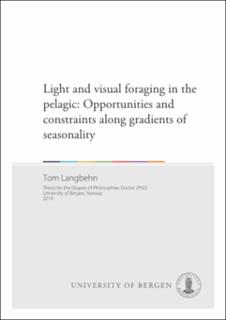| dc.description.abstract | Light has a twofold fundamental impact on marine ecosystems; it allows photosynthesis that is at the source of most marine food chains, but it also governs top-down control through visual foraging. Here, I focus on the latter. Seeing and doing are intrinsically linked. A broad range of marine taxa, from invertebrates, to seabirds and fish rely on vision, and thus light, for varied and complex behaviours such as navigation, signalling, predator evasion, finding food and orientation. This makes light one, if not the most important environmental factor governing species interactions in the pelagic, with consequences for the biogeography, ecology and evolution of life in the oceans.
Unlike in terrestrial systems, light gives structure in the otherwise featureless pelagic habitat, creating a lightscape of opportunities and constraints. Visual and behavioural adaptions to light are testament to the importance of the light regime along gradients of depth and latitude. One common behavioural strategy in the oceans in response to light is diel vertical migration, where organism ascend towards the surface with nightfall and sink to depth before sunrise. This behaviour is generally considered to arise from the trade-off between foraging and mitigating the risk of exposure to visually hunting predators. Towards higher latitudes, seasonality increases and organisms that live here cannot do so without special adaptations to deal with the seasons, including energy stores, dormancy or seasonal migration to latitudes with less seasonality. Adaptations that are advantageous in aseasonal environments, e.g. diel vertical migration, might not provide the same benefit in seasonal environments, or even become disadvantageous to fitness. Therefore, we must account for constraints and dependencies that differ with latitude and season, when studying species distributions and climate-driven range shifts.
Studying vertical distributions arising from predator-prey games in response to light has a long history in marine science and lake ecosystems. Few studies, however, have applied the same thinking across latitudinal gradients and into systems where the light regime becomes increasingly seasonal, fundamentally changing the rules of the game and therefore, which behavioural and life-history strategies become optimal in terms of Darwinian fitness.
In this thesis, I explore how light, and in particular visual search, may affect distribution patterns and the evolution of behavioural strategies to cope with various light regimes. The thesis includes three chapters that address different, but interlinked problems pertaining how the light regime governs pelagic foraging interactions. My approach is mechanistic and dynamic modelling rooted in evolutionary ecology. I focus on highlatitude marine systems, where the seasonality in light is extreme and the environment changes rapidly in response to climate change.
Specifically, in the first chapter, I quantify the potential for increased visual search as sea-ice declines in response to a warming climate. I find, that the reduced seasonal shading of the waters below the ice will boost visual search and extend the favourable foraging season for horizontal migrants, potentially benefiting the large sub-Arctic stocks of planktivorous fish, such as herring, capelin and mackerel. I predict, however, that the polar night will persist to be a bottleneck for visual foragers. I discuss the implications of increased top-down control through visual foraging on potential eco-evolutionary dynamics in a climate change context.
For the following two chapters, I developed a state-dependent model of optimal migration behaviour in mesopelagic fish that I calibrate and confront with empirical data. I apply the model to the case of the Norwegian Sea to test if extreme photoperiod at high latitudes explains the lack of success of mesopelagic fish in polar waters. My model suggests the midnight sun prevents mesopelagic fishes from safely migrating to the surface to feed, causing starvation at daytime depth. I further predict, that above the Arctic Circle, only sink population exists, because mesopelagic fish at higher latitudes are unable to build up surplus energy needed for reproduction to sustain populations. First, because they are unwilling to take the high extra risk associated with foraging during the summer month and second, because copepods migrate out of the surface waters during winter to depths where it is too dark to forage efficiently. The effect of temperature on vertical distributions was small compared to light. Based on the model results, rising temperatures will not facilitate poleward range extension of mesopelagic biogeography, but further aggravate starvation because of increased metabolic demands.
In conclusion, I provide model evidence that photoperiodic constraints shape the pelagic biogeography of high-latitude oceans, with likely ecological and evolutionary knock-on effects. The light regime should, therefore, be considered in range shift studies and guide our future research linking the epi- and mesopelagic realm. | en_US |
